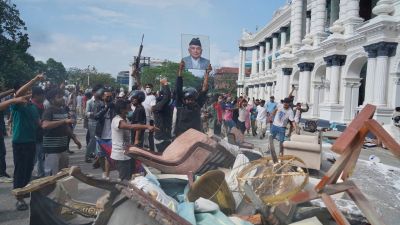Stay updated with the latest - Click here to follow us on Instagram
Mumbai: For honey collectors, the going gets tough in the city
"Even if there is one bee in it, they cringe. Everyone likes packaged goods available in shopping malls and big shops."
 A vendor at the honey sellers’ colony in Goregaon (East). Express Photo/Amit Chakravarty
A vendor at the honey sellers’ colony in Goregaon (East). Express Photo/Amit Chakravarty
Munna Mandal pushes back his shirt sleeve to reveal at least a dozen sting marks on his right forearm. “This is part of our job. The bees attack us since we are breaking their home,” says the 35-year-old honey seller.
Each morning, Munna along with other honey sellers settled in a Goregaon colony traverse the city and its far flung suburbs of Virar and Kalyan and even Vapi and Surat in Gujarat, craning their necks as they look for a beehive atop buildings or on trees. “There are a lot more glass buildings in Mumbai now which do not have beehives. The temperature of the city has also risen over the years. Bees are usually found in colder areas. So, we have to go to the outskirts now or to the jungles to find beehives,” says Munna.
Munna lives, along with over 50 other families, in the Khadakpada area of Goregaon, having come to the city in 2003 from Sultanganj in Bihar. Munna says the community has been traditionally working as honey sellers, their families migrating across various parts of the country in search of work.
“We carry dry grass and ropes when we leave to look for beehives. The grass is to burn the hive and one of us ties the rope tightly around the waist to climb heights,” says Deepak Mandal. While one man is released from a terrace or a parapet of the building towards the hive, two others give him instructions and hold the rope for his safety.
Apart from the rope, the men do not use any safety gear. “If we spot a hive, we ask the building watchmen if we can remove it. Some readily call us because they want the hive to be removed to prevent bee stings. Others refuse fearing that they would be held responsible if any of us hurts ourselves in a mishap,” says Deepak. The men say that they have not been involved in any accident so far but the risk is always on their mind. The injuries caused by the bee stings, he says, become a ‘habit’ over a period of time. It takes over half an hour to remove the hive and collect the honey in a container. “We sell it to the residents of the same building if they are willing or we go to the market place to sell it,” he says.
 “Even if there is one bee in it, they cringe. Everyone likes packaged goods available in shopping malls and big shops.” Express Photo/Amit Chakravarty
“Even if there is one bee in it, they cringe. Everyone likes packaged goods available in shopping malls and big shops.” Express Photo/Amit Chakravarty
“It hurts a lot initially. The pain is unbearable. But, this is the only job we know how to do,” says Raju Mandal. Depending on the size of the bee hive, the men manage to make Rs 300-500 per day. Most days, however, the hives are difficult to find. “It becomes difficult to bring enough money for a meal on such days especially during monsoon. If it does not sell, we sell it for as cheap as Rs 50 for a kilogram,” Munna says.
The community lives in makeshift tin-sheds in Goregaon without basic amenities. Members say that they find it difficult to enrol children in school since they keep moving from one place to another. Boys as young as 10 years of age are taken along with their fathers to gather honey, while women and girls are at home.
Over the years, the sale of honey has also reduced. The men say. “People are apprehensive about buying this honey directly removed from the hives. Even if there is one bee in it, they cringe. Everyone likes packaged goods available in shopping malls and big shops. You tell them that there are more impurities in the packaged honey, but they do not want to believe it,” Munna laughs.
The community has not stepped into the nearby mall where packaged honey is readily available off the shelves of multiple departmental stores. “There were not so many buildings when we came here. One could see till the highway. We didn’t travel too far then and people were more willing to buy honey from us,” says Seesh Kumari.
“Our men learnt all about this from a young age. We have never received any benefits or been given any other employment. If the trade keeps going down, we do not know how to survive,” she says.
 Express Photo/Amit Chakravarty
Express Photo/Amit Chakravarty







